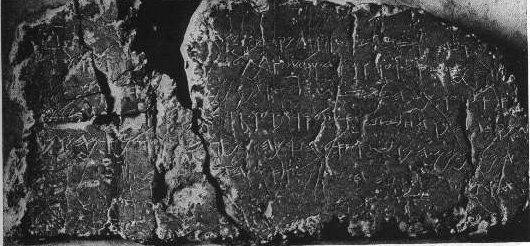
Image source: Jack Kilmon www.historian.net |
|
|---|---|
|
|
|
| Language: | Hebrew |
| Medium: | stone |
| Length: | 6 lines |
| Size: | 1.32 meters wide 0.21 meters high |
| Date: | c. 701 B.C.E. |
| Place of Discovery: | Silwan (village just east of Jerusalem) |
| Discoverer: | Jacob Spafford, a young boy |
| Epigrapher: | A. H. Sayce |
| Date of discovery: | 1880 |
| Present location: | Archaeological Museum of Istanbul Istanbul, Turkey |
| photo taken in museum: | photo by Dr. Carl Rasmussen |
| photo at original placement: | photo by Dr. Carl Rasmussen |
|
(Adapted from Cooke 1903:15 and Gibson 1971:22) |
(Adapted from Coote 1992:24) |
|
|
הנקבה וזה היה דבר הנקבה בעוד |
[. . .] the tunneling; and this was how the tunneling was completed: As [the laborers employed] | |
| הגרזן אש אל רעו ובעוד שלש אמת להנקב וישע קל אש ק | their picks, each crew toward the other, and while there were still three cubits remaining, the voices of the men calling out | |
| [ר]א אל רעו כי הית קדה בצר מימן [ומשם] אל ובים ה | to each other [could be heard], since it got louder on the right [and lef]t. The day the | |
| נקבה הכו החצבם אש לקרת רעו גרזן על [ג]רזן וילכו | opening was made, the stonecutters hacked toward each other, pick against pick. | |
| המים מן המוצא אל הברכה במאתי[ם ו]אלף אמה ומ[א] | And the water flowed from the source to the pool [twel]ve hundred cubits, | |
| ת אמה היה גבה הצר על ראש החצב[ם] | (despite the fact that) the height of the rock above the stonecutters' heads was one hundred cubits. | |
A cubit is an ancient unit of length, approximating the distance from the elbow to the end of the middle finger. The English word is from the Latin cubitum (“elbow”). |
||
| 1. Why would the construction of the tunnel be singled out among
Hezekiah's deeds (2 Kings 20:20; 2 Chronicles 32:30; Sirach 48:17)?
2. What role does the tunnel play in Isaiah's “argument” (Isaiah 22:11)? 3. What was the significance of city water systems in the ancient world relative to military strategies? 4. What other major water systems do we know about in ancient Jerusalem? Elsewhere in Syro-Palestine? |
| Albright,
W. F. “Palestinian Inscriptions.” In Ancient Near Eastern Texts
Relating to the Old Testament, edited by James B. Pritchard, 320-22. 3rd
ed. Princeton: Princeton Univ. Press, 1969.
Conder, C. R. “The Siloam Tunnel.” Palestine Exploration Fund Quarterly Statement 14 (1882) 122-31. Cooke, G. A. A Text-book of North-Semitic Inscriptions. Oxford: Clarendon, 1903. Coote, Robert B. “Siloam Inscription.” In Anchor Bible Dictionary, edited by David Noel Freedman, 6:23-24. New York: Doubleday, 1992. Gibson, John C. L. Textbook of Syrian Semitic Inscriptions. Vol. 1: Hebrew and Moabite Inscriptions. Oxford: Clarendon, 1971. Guthe, H. “Siloahinschrift.” Zeitschrift der deutsche morganländische Gesellschaft 36 (1882) 725-50. Mare, W. Harold. “Siloam, Pool of.” In Anchor Bible Dictionary, edited by David Noel Freedman, 6:24-26. New York: Doubleday, 1992. Sasson, Victor. “Siloam Tunnel Inscription.” Palestine Exploration Quarterly 14 (1982) 111-17. Sayce, A. H. “The Ancient Hebrew Inscription in the Pool of Siloam.” Palestine Exploration Fund Quarterly Statement 13 (1881) 69-73; 141-53; 282-85. Shiloh, Yigael. “Jerusalem's Water Supply During Siege—The Rediscovery of Warren's Shaft.” Biblical Archaeology Review 7.4 (1981) 24-39. Tarlar, David. “David, City of.” In Anchor Bible Dictionary, edited by David Noel Freedman, 2:52-67. New York: Doubleday, 1992. Ussishkin, David. “The Original Length of the Siloam Tunnel in Jerusalem.” Levant 8 (1976) 82-95. Wilkinson, J. “The Pool of Siloam.” Levant 10 (1978) 116-25. Younger, K. Lawson. "The Siloam Tunnel Inscription." In The Context of Scripture. Vol. 2, Monumental Inscriptions from the Biblical World, edited by William W. Hallo, 145-46. Leiden: Brill, 2000. |
 Return to K. C. Hanson's Collection of West Semitic Documents
Return to K. C. Hanson's Collection of West Semitic Documents Return to K. C. Hanson's HomePage
Return to K. C. Hanson's HomePage|
|
Last Modified: 18 April 2013
1488 א alef
1489 ב bet
1490 ג gimel
1491 ד dalet
1492 ה he
1493 ו waw
1494 ז zayin
1495 ח heth
1496 ט teth
1497 י yod
1498 ך kaf (final)
1499 כ kaf (medial)
1500 ל lamed
1501 ם mem (final)
1502 מ mem (medial)
1503 ן nun (final)
1504 נ nun (medial)
1505 ס samek
1506 ע 'ayin
1507 ף pe (final)
1508 פ pe (medial)
1509 ץ sadeh (final)
1510 צ sadeh (medial)
1511 ק qof
1512 ר resh
1513 ש shin
1514 ת taw